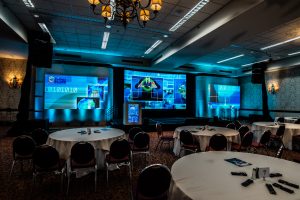Why it’s Important to Make the Case for Expanding Your AV Budget
When it comes to booking audio visual (AV) for your meetings, do you just order “the basics” and hope for the best?
May we suggest that you think beyond the basics. If you’re planning an annual event, you’ll want to provide that extra “wow” factor that will make attendees want to come back next year.
We asked Rental and Staging Network (EPN) member companies to share their tips about how to make the case for expanding the AV budget. EPN is comprised of more than 25 of the finest live-event staging companies; EPN members serve every major market in the United States, Canada and Mexico with best-in-class event AV.
“We ask clients about the importance of the meeting they’re planning,” said Donald Guzauckas Jr., vice president and general manager of HB Live Inc., an event production company and a member of EPN. “Is the meeting mission-critical for C-suite executives or is it to give an update to line staff? Simply considering the salaries of your attendees, what’s the true cost if they are disengaged during the presentation? Can you afford for that to happen?”

Why is AV important?
Think of what the words “audio” and “visual” really mean. Good audio enhances learning and retention. If members of the audience can’t hear, they’ll be disengaged. When it comes to visual, it’s about having adequate-sized displays for the audience size, not just for PowerPoint text or charts, but also for video content and motion graphics. If the screen is too small, your audience won’t comprehend the information or feel the impact that you intended to deliver.
AV costs typically make up a large portion of the event budget; in fact, they’re often the largest expenditures after food and beverage costs. Many planners, however, are surprised when they see how much event production costs.
“We often hear from meeting planners that they want to ‘up the wow factor’ or ‘it’s a special year for our organization,’”said Eric Newkirk, vice president of design and creative at CEAVCO, a live event and production company and EPN member. “The ability to do that is directly tied to upping the spending in AV. Keeping the budget the same, you will run out of options pretty quickly.”
What are your priorities?
Event planners often build event budgets around their priorities.
“I don’t blame anyone for prioritizing food and beverage for an event, but if it’s also important to demonstrate competency around the content of your meeting, then having an AV budget that matches should be a priority,” Guzauckas said. “When you think about it from that perspective and clarify your priorities, it can lead to a reallocation of budget dollars to AV.”
Looking to attract more attendees older than age 50? Consider providing assisted listening devices or live captioning to increase your audience. “It’s money well spent if you’re attracting people who might not otherwise be able to attend a live event due to impairment,” Newkirk said.
He said the type of event production displays used depends on the size and scope of each event.
“If a client is doing a big product launch and it’s a big-risk event with big impact, you’ll want to go with a bigger impact display,” Newkirk said. “But if you’re giving a business update to internal staff, you can use a lower impact display. It’s also important to consider if you need to record the event, do video conference or livestream. And if you’re recording an event and the quality is poor, it’s probably worthless.”
Lighting can set the mood and experience in the room and help delineate a change in speaker or a new part of the event. Using a microphone so the audience can hear questions during a Q&A session means attendees stay engaged. Adding AV technicians so that one person monitors every four breakout rooms—versus eight— means any technical glitches will be resolved faster. Increasing the time allotted for attendees to move from room to room means an AV technician can work to set up each presenter in advance to avoid any technical difficulties.
“Technical difficulties in anyone’s presentation, regardless of scale, are distractions that cost the audience time and money,” Guzauckas said.
What’s the risk of skimping on AV?
There can be sticker shock when event planners see how much AV can cost, but that’s typical because they’re comparing it to hosting an event in a company’s building or on their corporate campus, where AV is already integrated into the facilities. When an event is held off-site, costs can add up. The first day of any event is the most expensive because of the hard cost for the employees and the initial set up, Guzauckas said.
But if you underspend on AV and the event doesn’t run smoothly, your attendees are going to remember what went wrong, not the message you were trying to convey.
If you can add a little to the budget, you can get a lot in return for your investment, Newkirk said. “In a lot of cases, it means you can lower your risk and potential for something to go wrong. If your audience enjoys the experience, can hear and see well, gets inspired by the message and nothing got in the way of technology enhancing the delivery of that message nicely, then the takeaway experience is that their time and money were well spent.”


